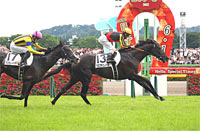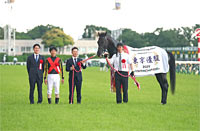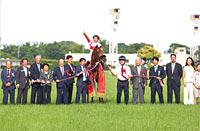Tokyo Yushun (Japanese Derby) (G1) - Data Analysis
Horses sired by Japanese Derby winners have won six years in a row
“Japanese Derby winner” is one of the most coveted titles in Japan’s horseracing. After winning the race in 2005, Deep Impact sired the Japanese Derby winners of 2012, 2013, 2016, 2018, 2019, and 2020. Meanwhile, 2004 winner King Kamehameha sired the winners of 2015 and 2017. In other words, eight of the last 10 Japanese Derbies have been won by the offspring of previous Japanese Derby winners. Will the same trend play out this year or will another scenario unfold? Let’s now look for some trends in this race based on results over the last 10 years.
Strong performance by runners backed as 1st and 3rd favorite
Looking at performances by runners over the last 10 years in terms of favoritism, we find that runners backed as 1st and 3rd favorite achieved a Top 3 ratio of 70.0%, delivering stable performance. Runners backed as 2nd favorite also had a decent Top 3 ratio of 40.0%, and in the last 10 years, there has been only one case in 2018, when the runners backed as 1st-3rd favorite were all beaten to 4th or lower. In 2018, 16th favorite Cosmic Force finished in third place, resulting in a substantial Trifecta payout of 2,856,300 yen. In addition, 12th favorite Roger Barows triumphed in 2019, and 10th favorite Weltreisende finished in third place in 2020. Given that runners backed as 10th or lower have performed well in the last two years, we need to consider the fact that dark horses may surprise us again this year. [Table 1]
[Table 1] Performance by favoritism (last 10 years)
| Favoritism |
Performance
[1st-2nd-3rd-4th or lower] |
Win ratio |
Top 2 ratio |
Top 3 ratio |
| 1st favorite |
4-1-2-3 |
40.0% |
50.0% |
70.0% |
| 2nd favorite |
1-2-1-6 |
10.0% |
30.0% |
40.0% |
| 3rd favorite |
3-3-1-3 |
30.0% |
60.0% |
70.0% |
| 4th favorite |
0-1-0-9 |
0% |
10.0% |
10.0% |
| 5th favorite |
1-2-0-7 |
10.0% |
30.0% |
30.0% |
| 6th-9th favorite |
0-0-3-37 |
0% |
0% |
7.5% |
| 10th favorite or lower |
1-1-3-84 |
1.1% |
2.2% |
5.6% |
Focus on number of wins in JRA graded races
Cosmic Force, Roger Barows, and Weltreisende, which have already been mentioned above, had not won a previous JRA graded race. However, runners without a previous victory in a graded JRA race have only produced one winner (Roger Barows) over the last 10 years, resulting in a Win ratio of 1.3%. This suggests winning the Japanese Derby is no easy task for runners without a previous victory in a graded JRA race. Last year, Contrail and Salios finished in 1st and 2nd position, respectively, with previous records of three and two wins in JRA graded races. In other words, runners with a higher number of wins in previous JRA graded races have achieved higher success ratios in the Japanese Derby over the last 10 years, which is in line with expectations. [Table 2]
[Table 2] Performance by number of wins in JRA graded races (last 10 years)
| Number of wins |
Performance
[1st-2nd-3rd-4th or lower] |
Win ratio |
Top 2 ratio |
Top 3 ratio |
| 3 |
1-1-0-3 |
20.0% |
40.0% |
40.0% |
| 2 |
2-1-2-9 |
14.3% |
21.4% |
35.7% |
| 1 |
6-8-3-68 |
7.1% |
16.5% |
20.0% |
| 0 |
1-0-5-69 |
1.3% |
1.3% |
8.0% |
Watch runners coming from the Satsuki Sho
Looking at performances by runners over the last 10 years in terms of the previous race, we observe that 20 of the 30 Top 3 finishers had contested the Satsuki Sho (Japanese 2000 Guineas) in their previous race. In addition, runners coming from the Kyoto Shimbun Hai have produced two winners. Runners that had contested the TV Tokyo Hai Aoba Sho (Japanese Derby Trial) in their previous race have only produced one runner-up, while runners coming from the Principal Stakes have only produced one third-place finisher. This suggests we should remove runners coming from Japanese Derby trials from the list of win contenders. In addition, runners that had contested the NHK Mile Cup or the Mainichi Hai in their previous race were all beaten to 4th or lower. It would therefore be a good idea to lower our expectations of runners that either will be facing a major increase in distance in the Japanese Derby, or enter the race after a significant interval. [Table 3]
[Table 3] Performance by previous race (last 10 years)
| Previous race |
Performance
[1st-2nd-3rd-4th or lower] |
Win ratio |
Top 2 ratio |
Top 3 ratio |
Satsuki Sho
(Japanese 2000 Guineas) |
8-7-5-68 |
9.1% |
17.0% |
22.7% |
| Kyoto Shimbun Hai |
2-1-1-20 |
8.3% |
12.5% |
16.7% |
| TV Tokyo Hai Aoba Sho (Japanese Derby Trial) |
0-2-3-19 |
0% |
8.3% |
20.8% |
| Principal Stakes |
0-0-1-8 |
0% |
0% |
11.1% |
| NHK Mile Cup |
0-0-0-22 |
0% |
0% |
0% |
| Mainichi Hai |
0-0-0-4 |
0% |
0% |
0% |
| Other race |
0-0-0-8 |
0% |
0% |
0% |
No victories from runners with experience of contesting 2,400m turf races
We mentioned above that runners coming from the TV Tokyo Hai Aoba Sho (contested at the same racecourse as the Japanese Derby) have produced zero winners. We note that this trend is not limited to runners coming from the TV Tokyo Hai Aoba Sho, but is true for all runners that had previously contested a 2,400m turf race over the past 10 years. Even going back as far as 1984, when the grading system was introduced, we find that runners with experience of contesting a 2,400m turf race have not produced a single winner, so we should remember that experience in long-distance races is not necessarily an advantage. [Table 4]
[Table 4] Performance by experience of contesting a previous 2,400m turf race (last 10 years)
| Experience |
Performance
[1st-2nd-3rd-4th or lower] |
Win ratio |
Top 2 ratio |
Top 3 ratio |
| Yes |
0-3-4-27 |
0% |
8.8% |
20.6% |
| No |
10-7-6-122 |
6.9% |
11.7% |
15.9% |
In addition, among the 23 Top 3 finishers that had not previously contested a 2,400m turf race, 20 had finished in the Top 3 of a turf 2,000-2,200m G1 or G2 race. Runners without such experience struggled with a Top 3 ratio of 3.8%. In other words, some success in middle-distance races should be viewed as essential. [Table 5]
[Table 5] Among runners that had not previously contested a 2,400m turf race, performance by experience of finishing in the Top 3 of a turf 2,000-2,200m G1 or G2 race (last 10 years)
| Experience |
Performance
[1st-2nd-3rd-4th or lower] |
Win ratio |
Top 2 ratio |
Top 3 ratio |
| Yes |
10-6-4-45 |
15.4% |
24.6% |
30.8% |
| No |
0-1-2-77 |
0% |
1.3% |
3.8% |
Seek out the winner!
Previous race warrants close attention
As indicated in Table 3, the last 10 winners all came from the Satsuki Sho or the Kyoto Shimbun Hai, so we should start by checking the previous race of the runners. Next, when observing the jockey of the winners, we find that the last 10 winners were ridden by the same jockey as in the previous race. It would therefore seem wise to focus more on runners ridden by the same jockey than on those ridden by a different jockey. Finally, runners that had a time difference of 1.0s or more with the winner in their previous race, and those that were backed as 6th favorite or lower in their previous race produced zero winners. This suggests the chances of such runners vying for the top spot are limited. [Table 6] [Table 7] [Table 8]
[Table 6] Performance by jockey (last 10 years)
| Jockey |
Performance
[1st-2nd-3rd-4th or lower] |
Win ratio |
Top 2 ratio |
Top 3 ratio |
| Same jockey as in previous race |
10-9-7-92 |
8.5% |
16.1% |
22.0% |
| Different jockey from previous race |
0-1-3-57 |
0% |
1.6% |
6.6% |
[Table 7] Performance by finish and time difference with winner in previous race (last 10 years)
| Finish and time difference with winner in previous race |
Performance
[1st-2nd-3rd-4th or lower] |
Win ratio |
Top 2 ratio |
Top 3 ratio |
| 1st |
4-5-4-31 |
9.1% |
20.5% |
29.5% |
| 2nd or lower with time difference with winner of less than 1.0s |
6-5-4-79 |
6.4% |
11.7% |
16.0% |
| 2nd or lower with time difference with winner of 1.0s or more |
0-0-2-39 |
0% |
0% |
4.9% |
[Table 8] Performance by favoritism in previous race (last 10 years)
| Favoritism in previous race |
Performance
[1st-2nd-3rd-4th or lower] |
Win ratio |
Top 2 ratio |
Top 3 ratio |
| 5th favorite or higher |
10-8-8-71 |
10.3% |
18.6% |
26.8% |
| 6th favorite or lower |
0-2-2-78 |
0% |
2.4% |
4.9% |
(Maya Takanami)
|

- Preview
- Barrier draw
- Past performances of runners

- News
- Race result
- Video
- 2025 English

- 2024 English

- 2023 English

- 2022 English

- 2021 English

- 2020 English

- 2019 English

- 2018 English

- 2017 English

- 2016 English

- 2015 English

- 2014 English

- 2013 English

- Photo Gallery
2025 Winner: Croix du Nord


2024 Winner: Danon Decile


|



















